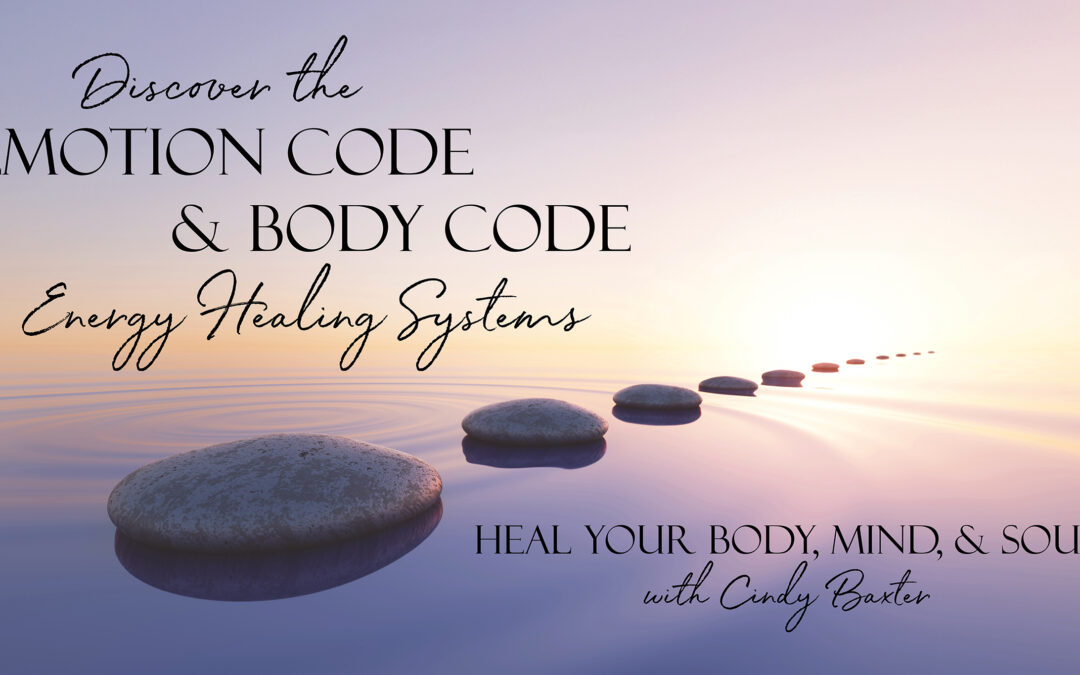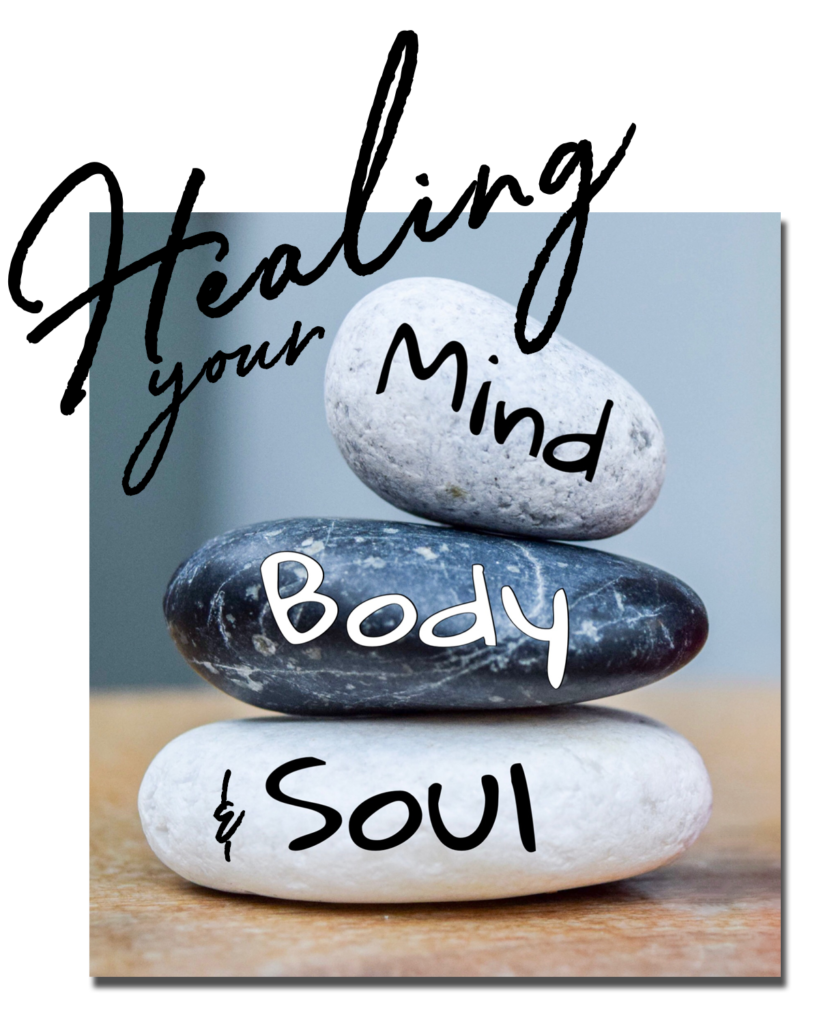
by Cindy Baxter | Oct 29, 2024 | Body Code, Emotion Code
Heal from Within:
Uncover the Emotional and Physical Blocks Keeping You from True Wellness
Discover healing with the Emotion Code. Uncover true well-being by releasing hidden energetic imbalances that may be holding you back. Whether you’re dealing with physical discomfort, health concerns, or emotional challenges, the Emotion Code and Body Code systems offer a pathway to restore balance. These techniques allow your body to heal naturally.
Are you ready to experience natural healing? Are you ready to embrace a life free from physical and emotional pain, with newfound clarity, energy, and peace?
Read on and explore how these powerful, non-invasive healing techniques can transform your health from the inside out.
For More Detailed Descriptions of the Emotion Code and Body Code
CLICK THIS LINK
From Skepticism to a Healed Heart — How Emotion Code and Body Code Changed My Life
Nearly six years ago, I was introduced to the remarkable healing modalities of the Emotion Code and Body Code. Since then, my journey has been transformative. Like many, I was skeptical. Could “energy” healing really work? I decided to give it a try; it certainly couldn’t hurt.
In my first session with a Body Code practitioner from Canada, we uncovered a trapped emotion in my right ankle. I said, “That’s interesting—I’ve been having trouble with that ankle; it keeps giving out on me!” My practitioner confidently replied, “No worries, I’ll release that now. Your ankle should feel strong and stable again.” Even more remarkable than Eileen finding that trapped emotion in my ankle was that the emotion she discovered perfectly matched an emotional experience I’d had earlier that year. My skepticism began to fade. As days turned to months, and now years, I am amazed that I haven’t experienced any issues with that ankle since.
A Journey of Ongoing Healing
That session was just the beginning. I continued working with Eileen on and off for years to manage stress and keep my emotional energy, life, and health in balance. Each session made me feel lighter, calmer, and more centered. My emotional well-being improved dramatically.
 Healing During My Darkest Time
Healing During My Darkest Time
I truly discovered the depth of healing the Emotion Code and Body Code could bring during one of the most heart-wrenching times of my life. I was emotionally shattered, with my heart and soul broken in ways I didn’t know were possible. Yet, traditional coping methods couldn’t reach the pain deep inside me.
That’s when I turned again to the Emotion Code and Body Code—my lifeline in that dark time. With the help of a new practitioner from California named Missy, we uncovered layer after layer of trapped emotions. These stored emotional pains affected how I felt and moved through life. I was amazed by how she could pinpoint each exact age where I experienced trauma and release it. I began to realize that these negative emotional energies trapped in my body had been tied to years of physical pain and mental discomfort. But in the darkest moment of my life, I truly believe that through Body Code and the friendship we formed, Missy didn’t just heal my broken heart and soul—she quite literally saved my life.
Transforming My Life Through Emotional Release
One by one, Missy released hundreds of trapped emotions, beginning with the most recent and eventually going all the way back to my childhood. The process transformed me. Each release lifted a weight I hadn’t realized I carried. It gradually mended my broken heart and restored peace to my soul.
 Finding Peace and Wholeness Today
Finding Peace and Wholeness Today
Today, I can honestly say that Emotion Code and Body Code were the catalysts to the peace and wholeness I now experience every day. They didn’t just heal my emotional wounds. They helped me rediscover a lightness of being and calm I thought was lost forever.
If you’re carrying emotional baggage or physical pain that weighs you down, or if you’re feeling disconnected from yourself and your purpose, I invite you to take this journey with me. Let me help you discover healing with the Emotion Code System. Although, these energy healing modalities treat so much more than just heartbreak and emotional trauma. Please read on to see all the amazing benefits for healing I can assist you with.
Click here to see a list of ways I can help. CLICK HERE
The profound transformation I experienced inspired me to become a certified Emotion Code and Body Code practitioner. Now, I’m dedicated to guiding others on their healing journey, sharing these powerful techniques to help heal broken hearts, broken souls, and broken bodies. My mission is to lead others toward their own path to peace and wholeness.
The Emotion Code and Body Code are comprehensive energy healing systems that address emotional discomfort and so much more!
Yes! I’m ready, Cindy! If it helped you I’m sure it can help me!
SCHEDULE HERE
Is Your Body Sending You Signals?
Discover Healing with the Emotion Code for Lasting Relief
- Persistent tension or aches and pains in your body
- Feeling tired or drained even after rest
- Digestive discomfort, bloating, constipation, or diarrhea
- Trouble sleeping or waking up feeling tired
- Emotional fluctuations like intense sadness or anger
- A sense of overwhelm or feeling stressed
- Feeling stuck in your personal or professional life
- Difficulty letting go of the past
- Self-sabotaging behaviors or unproductive habits
- Chronic procrastination
- Addictive behaviors
- A sense of disconnect from your true purpose
- Feeling lost in life
- Suffering from childhood trauma
- Suffering intensely from the loss of a loved one
Here are a Few Examples of How My Clients Discovered Healing with the Emotion Code and Body Code
Uncovering Hidden Toxins: Ashley’s Journey to Wellness
 Take Ashley, a client from Australia for example. During her Body Code session, we discovered that a food toxin—Sucralose—was disrupting the balance in her body. Ashley was shocked. As someone who was extremely health-conscious, she believed she was doing everything right and would never knowingly put such a harmful substance into her system.
Take Ashley, a client from Australia for example. During her Body Code session, we discovered that a food toxin—Sucralose—was disrupting the balance in her body. Ashley was shocked. As someone who was extremely health-conscious, she believed she was doing everything right and would never knowingly put such a harmful substance into her system.
It turned out the culprit was an energy drink she had been consuming, believing it was a “healthy” option because it boasted zero calories. Little did she know, drinking it unknowingly introduced artificial ingredients that poisoned her system. The Body Code helped uncover this hidden toxin, allowing her to remove it from her diet and restore her body’s natural balance.
Feeling off? Low energy? Body aches and pains? You might be dealing with hidden toxins—like dental toxins, biological poisons, food toxins, drug toxins—or even imbalances like excess or low nutrients, toxic sound, or excess stress. With the Body Code system, we can uncover exactly what’s troubling your body and help restore balance naturally.
Breaking Down Emotional Barriers: Anna’s Heart Wall Transformation
 And then there’s Anna. She had been struggling to find love for several years after her last breakup. No matter what she tried, love seemed completely out of reach. Through Emotion Code, we discovered that Anna had a Heart Wall—a protective barrier made of trapped emotions that forms around the heart to shield it from emotional pain. While this barrier can protect us during difficult times, it also blocks our ability to give and receive love fully, affecting our relationships on every level.
And then there’s Anna. She had been struggling to find love for several years after her last breakup. No matter what she tried, love seemed completely out of reach. Through Emotion Code, we discovered that Anna had a Heart Wall—a protective barrier made of trapped emotions that forms around the heart to shield it from emotional pain. While this barrier can protect us during difficult times, it also blocks our ability to give and receive love fully, affecting our relationships on every level.
Typically, a Heart Wall can be cleared in 3 to 5 sessions, but Anna’s emotional block was deeper. After 9 sessions, her Heart Wall was fully released. Just a few weeks later, Anna found a new love—something she had been longing for but couldn’t access until the emotional barriers around her heart were removed.
Heart Walls affect all of our relationships, not just romantic ones. They create distance between us and the people we care about, limiting our ability to connect deeply and preventing us from fully embracing the love, joy, and peace we desire. By releasing the Heart Wall, we open ourselves to more authentic, fulfilling connections in every area of life.
Feeling stuck in your relationships? Struggling to connect deeply or find love? You may have a Heart Wall—a barrier of trapped emotions blocking you from the love and joy you deserve. With the Emotion Code, we can release these emotional blocks and help you experience more meaningful, fulfilling relationships.
Uncovering Hidden Dangers: How Body Code Helped Lisa’s Son
Lisa, a loving mother and beautiful soul I had been working with, reached out with concern for her toddler son. His sleep had become restless, and his normally cheerful demeanor seemed off. Worried, she asked if I could work with him using Body Code. “Of course,” I said, “with your permission, I can.”
As we explored what could be causing the disturbance, Body Code uncovered a few imbalances related to his teeth—new teeth that hadn’t quite broken through yet. But there was something else. We discovered an environmental toxin: carpet. I asked Lisa, “Did you recently get new carpet?” She thought for a moment and then exclaimed in horror, “No, but I did buy a brand-new large area rug! I placed it under his crib, where he crawls around and I change him.”
The Hidden Danger in Everyday Items
The connection became clear. The new rug had an odor that was likely releasing harmful chemicals into the room. Lisa quickly checked, and sure enough, there was a smell she hadn’t noticed before. “God only knows where and how the household items we use are made,” she said. It’s frightening to realize how unaware we can be of the toxins hiding in everyday products that affect our homes, our health, and especially our children.
Lisa immediately removed the rug, and soon after, her son’s sleep returned to normal. His teeth finally came through, and his mood brightened once again.
Feeling concerned about your home environment? Hidden toxins like mold, heavy metals, and electromagnetic radiation may impact your family’s health without your awareness. With the Body Code, we can uncover these hidden dangers and restore balance, helping you and your loved ones feel better naturally.
Healing a Lifetime of Wounds: Dave’s Journey to Peace
 Dave, a good friend and someone who had been through more than his fair share of life’s challenges, knew he carried deep wounds. Like many of us, he had endured blow after blow, leaving him lost and disconnected, with no clear sense of purpose or direction. Curious about how Emotion Code and Body Code could help, Dave reached out, hoping for relief.
Dave, a good friend and someone who had been through more than his fair share of life’s challenges, knew he carried deep wounds. Like many of us, he had endured blow after blow, leaving him lost and disconnected, with no clear sense of purpose or direction. Curious about how Emotion Code and Body Code could help, Dave reached out, hoping for relief.
As we began our work together, Body Code revealed a trapped emotion of abandonment—one that was lodged in his right shoulder blade. “Wow,” he said, “that’s the exact spot that has bothered me for so long.” With just one release, Dave felt an instant sense of relief, both physically and emotionally.
A Journey Through Layers of Healing
From that moment, we continued as a team—his subconscious mind guiding us, and me working through Emotion Code and Body Code to find and release layer after layer of unresolved, trapped emotions that had been weighing him down. Dave was astonished at how precisely the system could pinpoint the exact emotions he had experienced at different points in his life, from childhood all the way to adulthood.
Together, we uncovered and released countless deep-seated wounds—pain that Dave had unknowingly carried for years. Though he’s not yet at the end of his journey, Dave already feels transformed. His body, mind, and soul are healing, bringing him to a far more peaceful and centered place, with his self-esteem steadily rising. Dave describes his experience with Body Code as nothing short of life-changing, helping him finally release the emotional weight he’d been carrying for so long.
Feeling weighed down by past wounds or emotional burdens? Just like Dave, you can discover healing with the Emotion Code or Body Code, releasing the hidden emotions that hold you back. The Body Code helps you clear away these deep-seated blocks, restoring peace and empowering you to move forward with renewed strength and purpose.
CLICK HERE
Let’s Focus on You
 I could go on and on, sharing countless stories of transformation and healing, but instead, let’s focus on you. After a year and a half of aiding countless clients, and with my own personal experience and healing transformation, I’ve seen firsthand the profound changes this work can bring. Let’s get you scheduled for a session and start uncovering the hidden imbalances in your life. Whether it’s physical discomfort, emotional wounds, or feeling stuck in your path, let me help you discover healing with the Emotion Code System so you can find the physical and emotional peace you’ve been searching for.
I could go on and on, sharing countless stories of transformation and healing, but instead, let’s focus on you. After a year and a half of aiding countless clients, and with my own personal experience and healing transformation, I’ve seen firsthand the profound changes this work can bring. Let’s get you scheduled for a session and start uncovering the hidden imbalances in your life. Whether it’s physical discomfort, emotional wounds, or feeling stuck in your path, let me help you discover healing with the Emotion Code System so you can find the physical and emotional peace you’ve been searching for.
Yes! I’m ready, Cindy! If it worked for them it can work for me!
SCHEDULE HERE
The Future of Healing Is Here: Why Discover Healing with the Emotion Code and Body Code?
Imagine going beyond symptom management to actually address the root causes of discomfort. The Body Code offers this approach by restoring harmony to your body’s energy. Whether you’re dealing with physical discomfort, emotional heaviness, or a general feeling of imbalance, this system removes obstacles that stand in the way of your wellness.
Healing isn’t just about masking symptoms; it’s about uncovering and correcting the true causes of imbalance. You can discover healing with the Emotion Code, a foundational part of this approach, by identifying and releasing specific trapped emotions, promoting emotional and physical well-being. The Body Code goes even further, locating and releasing various forms of imbalance—from energy misalignments to toxins—empowering your body to heal itself naturally.
While traditional medicine excels at treating acute physical issues, many of us face chronic discomfort or emotional challenges that aren’t fully addressed by conventional methods. This is where energy healing bridges the gap, offering a pathway to discover healing with the Emotion Code or Body Code Systems and unlock a higher level of health and well-being.
Finding Your Path to Peace with the Emotion Code and Body Code System
 Life can burden us with emotional baggage, physical discomfort, low energy, and a sense of being stuck. Often, these challenges are rooted in past experiences or trapped emotions that linger in the body, for years, affecting how we feel, move, love and think. But you don’t have to carry those burdens any longer.
Life can burden us with emotional baggage, physical discomfort, low energy, and a sense of being stuck. Often, these challenges are rooted in past experiences or trapped emotions that linger in the body, for years, affecting how we feel, move, love and think. But you don’t have to carry those burdens any longer.
Through the transformative power of Emotion Code and Body Code, we can release the emotional and energetic imbalances that manifest as persistent aches, tiredness, digestive issues, troubled sleep, or overwhelming stress. We can uncover the root causes behind feeling disconnected from your purpose, trapped by old patterns, or burdened by emotional weight that keeps you from thriving.
Together, we will work to free you from the emotional scars and physical discomforts holding you back. This journey will help you reclaim your vitality, mental clarity, and inner calm. These natural, non-invasive methods allow you to live with more ease, peace, and balance.
Ready to Discover Healing with the Emotion Code Systems?
If you’re ready to explore what the Body Code can do for you, join one of our live events, where we work with real people in real time.
Or schedule your own personalized session and begin your journey toward deeper healing and balance. Unlock the potential within your body and embrace a healthier, happier life.
Walk with me on this path to peace, and leave behind the pain, the stress, the suffering and the emotional weight of your past behind.
It’s time to heal and step into a life of clarity, wellness, and joy.

by Cindy Baxter | Aug 16, 2024 | General
What if you looked at challenging people as teachers in disguise? These challenging characters arrive precisely when you needed them most. It’s common for us to view difficult interactions with others as disruptions to our peace. But what if these challenges are essential for your soul’s growth? They may not be entering our lives to create chaos. Instead, they push us toward deeper understanding, emotional resilience, and spiritual evolution. These individuals act as catalysts, prompting us to look inward and confront the aspects of ourselves that require healing.
Difficult people are the greatest teachers. They reveal our weaknesses, vulnerabilities, and give us opportunities to rise above them.
– Cindy Baxter
Difficult People: Teachers Who Reflect Our Hidden Strengths

Think about that coworker who challenges you at every turn. These challenging people are teachers in disguise, pushing you to develop assertiveness. They question your decisions and test your patience. While it’s easy to view them as obstacles, what if they’re here to help you grow? They may be teaching you to trust your instincts, stand your ground, and set boundaries. Through their resistance, they make you stronger. These lessons will serve you in all areas of life, helping you become more self-assured.
The Lesson of Self-Worth
Now consider a family member who never seems satisfied, no matter how much you do to please them. Perhaps they are teaching you the crucial lesson of self-worth. You cannot rely on external validation to feel good about yourself. By facing their impossible expectations, you’re invited to look within. Your value isn’t dependent on others’ opinions. These situations challenge you to cultivate self-love and acceptance. You will begin to realize that your worth comes from within. Every time I encounter someone challenging, I pause and ask my higher self, God, Source, or the Universe, “What am I meant to learn from this situation?” Embracing the belief that life is happening for you, not to you, can change everything. Every experience is an opportunity for growth. Now that I’ve healed from six decades of what I once saw as abuse, I realize I was never a victim of criticism or betrayal. Instead, I was a student of profound lessons, leading me to a deeper understanding of life in general and to a profound personal transformation.
A Shift in Perspective
If you can you take a step back and look at these challenging people and situations more objectively, I promise, your life will transform before your very eyes.
My Personal Journey: Lessons from a Critical Mother
This lesson really hit home. My mother was extremely critical of me—I could never do anything good enough in her eyes. For years, I constantly strived for her approval. While her criticism was harsh and hurtful, I now see that it was a pivotal factor in shaping who I am today. It became one of the key reasons I’ve successfully run a business for over four decades. Her inability to recognize my worth pushed me to strive for perfection and to please her in every way I could. The criticism turned me into a people-pleaser, a trait my clients appreciated. However, in hindsight, people-pleasing is not a skill one should strive for. Still, in my case, it served me well in building an extraordinary photography career, one in which I am very proud.
The Healing Power of Challenging Relationships
There always seems to be that friend or romantic partner who triggers our deepest insecurities. They make us feel inadequate or unworthy. While their behavior is extremely hurtful, what if they are here to illuminate the unresolved wounds within us that need healing? Through your interactions with them, you are given the opportunity to confront those parts of yourself that feel small, scared, or unworthy. Though difficult, these relationships guide you to a deeper level of self-awareness. They help you recognize and heal the insecurities that have held you back.
Viewing Challenging Relationships as Opportunities: Embracing Teachers in Disguise
Life often presents us with relationships that are challenging, sometimes even painful. These experiences can feel overwhelming, and they may pierce deep into our hearts and egos. The hurtful words, actions, and behaviors of others can leave lasting scars, making us feel unworthy, rejected, or misunderstood. But in those moments, it’s important to remember that these aren’t just random acts of cruelty or personal attacks—they are lessons, opportunities for growth, and invitations to heal that our soul chose for our highest good.
Seeing the Bigger Picture
When we step back and reflect on these painful moments, we begin to see a different perspective. It’s easy to internalize the hurt, thinking it’s a reflection of our flaws or shortcomings. However, the truth is that the negative behavior of others rarely has anything to do with us at all. Their words and actions are often a mirror of their own unresolved pain and struggles. They’re expressing their own wounds, projecting them onto us, even if unknowingly.
There was a time when I felt overwhelmed by the actions of my mother and ex-husband, both of whom caused me emotional pain. Reflecting on the situation, I asked myself, “What happened to them in their lives that made them believe it was okay to treat me this way?” This shift in perspective allowed me to approach the situation with compassion instead of resentment. It became clear that their hurtful behavior wasn’t about me—it was rooted in their own unresolved traumas and pain.
The Gift of Empathy and Forgiveness
In that moment, I chose to feel empathy for them. I understood that their actions were a manifestation of their suffering, not a reflection of my worth. This realization opened my heart to forgiveness. Forgiveness, in this case, was not a gift to them—it was a powerful gift to myself. It freed me from the emotional burden of carrying resentment and allowed me to reclaim my peace.
The act of forgiving them was a profound turning point in my journey. It helped me release the grip that their behavior had on me, and it allowed me to heal. Instead of seeing them as villains in my story, I began to see them as fellow travelers on the path of pain, who were simply doing the best they could with the tools they had. This shift in perspective brought me a sense of peace and freedom that I had been seeking for so long.
When we can view the difficult people in our lives as teachers, rather than sources of suffering, we unlock the power to transform our pain into wisdom. And in doing so, we free ourselves from being bound by their actions and start walking the path of healing and self-love.
You Are Not Alone
If you are experiencing this in your life, you are not alone. I speak with people every day who suffer from relationships like this. In my own experience with a narcissistic mother and narcissistic romantic partners, feelings of unworthiness were always front and center. By the end of my last marriage, I could clearly see how my husband’s actions triggered the emotional wounds left by my mother. That relationship, as difficult as it was, served as the catalyst for deep healing and self-love. In hindsight, he was a gift—a painful yet invaluable one that led me to a path of profound growth and healing.
Difficult People as Mirrors for Self-Discovery
These difficult people, whether they are coworkers, family members, romantic partners, or friends, serve as mirrors. Remember, challenging people are teachers in disguise who reflect back the parts of ourselves that we might otherwise overlook. When someone triggers anger or frustration within us, it’s a signal to examine those emotions more closely. What are they revealing about our insecurities, fears, or unresolved wounds? By engaging with these difficult personalities, we embark on a profound journey of self-discovery.
The purpose of these challenges isn’t to break us down but to build us up. Each difficult person serves as a guide, albeit a tough one, showing us where we need to grow. They push us to set boundaries, teaching us the value of self-respect and self-preservation. In doing so, we learn to protect our peace while still engaging with the world around us. Boundaries aren’t just about keeping others at a distance; they’re about declaring our worth and ensuring that we honor our own needs.
Empathy and Forgiveness: The Keys to Your Personal Peace
Moreover, these teachers invite us to practice forgiveness—not just for their actions, but for ourselves. Forgiveness allows us to release the grip of resentment that keeps us tethered to the past. It frees us to move forward with a lighter heart and a clearer mind. In forgiving others, we often find that we are the ones who benefit the most, as we reclaim our emotional freedom and peace of mind.
The Power of Empathy
But beyond boundaries and forgiveness, one of the most powerful lessons challenging people as teachers impart is empathy. It’s easy to react in anger when someone mistreats us, but we don’t always know the full story of their struggles. Perhaps that coworker who constantly challenges you is dealing with immense pressure at home, or the family member who criticizes you endlessly might be battling their own feelings of inadequacy. By extending empathy, we can shift our perspective, recognizing that everyone carries unseen burdens.
Take, for example, the familiar situation of someone cutting you off in traffic. Your first instinct might be to throw them a gesture of frustration—perhaps the “bird.” But before you react, consider this: when you flip that middle finger, it is simply just one finger away from the peace sign. Instead of reacting with anger, what if you threw them a little peace? You don’t know if they’re rushing to a loved one who’s in the hospital, desperately trying to make it in time. Or maybe they’ve just received devastating news and aren’t thinking clearly. Perhaps they’re overwhelmed by the stress of juggling work, finances, and family. When we choose to respond with empathy rather than anger, we offer a small gift of kindness to a world that often feels harsh.
Empathy and forgiveness for others is not about letting them off the hook; it’s about freeing yourself from the chains of bitterness and resentment. Holding on to anger and unforgiveness only keeps us bound to the past, allowing negative emotions to fester and erode our peace. Empathy allows us to transcend the boundaries of the self, stepping into the sacred space of another’s experience. It’s not about excusing their actions, but about choosing to protect our inner peace and emotional well-being. By forgiving, we break free from the grip of negativity, allowing ourselves the space to heal and move forward with clarity and tranquility.
For more insights on the transformative power of forgiveness, be sure to check out my blog post, ‘The Healing Power of Forgiveness.’
Embracing Challenging People as Catalysts for Spiritual Growth
In these challenging times, empathy serves as the bridge that connects hearts across the gaping chasms of misunderstanding and discord. When we practice empathy, we transcend the boundaries of the self, stepping into the sacred space of another’s experience. Such a profound act of communion is a testament to the interconnectedness of all beings. Consider walking in the shoes of another, feeling the weight of their struggles as if they were your own. In that moment of shared vulnerability, barriers dissolve, and understanding blooms like a fragile flower in the desert of indifference.
Ultimately, challenging people are teachers in disguise who come into our lives for a reason. They help us shed old patterns and rise to new levels of consciousness. Arriving in our lives at the right moments, they push us toward becoming the best version of ourselves. These difficult teachers help us heal deep wounds and guide us to new levels of growth. In the grand scheme of life, they are not here to harm us but to help us ascend. When we embrace this perspective, we begin to see that every encounter—no matter how challenging—is an opportunity for growth. We realize that these difficult teachers are guiding us toward the expansion of our soul, helping us become who we are truly meant to be.
 Let Me Guide You on Your Path to Peace
Let Me Guide You on Your Path to Peace
If you’re struggling with anger, betrayal, or facing a tough situation that’s weighing you down, consider reaching out to me for help. I understand your grief, your frustration, and your desire to find peace because I’ve lived it. My life has been filled with a myriad of unpleasant people—corrupt and thieving business partners, dishonest employees, backstabbing friends, cheating romantic partners, and even a narcissistic spouse and mother. In my six decades of life, I’ve learned many lessons, and perhaps the most important is that life will continue to throw you curveballs, teaching you lesson after lesson until you finally get it.
Believe me, my life hasn’t been the bed of roses that those on the outside believed it to be. Don’t get me wrong, I’ve had my share of great times, but unfortunately, those moments have long been forgotten. Isn’t it ironic that the good times roll by like water off a duck’s back, but the bad times, the challenging moments, cling to us like thorns in our hearts, refusing to let go? Spirituality has been the catalyst and my path to peace, helping me transform those thorns into seeds of growth. Let me guide you on a journey to your own path to peace.
How I Can Help
I’m Cindy Baxter, a Certified Emotion Code and Body Code Practitioner and Spiritual Life Coach. Through energy healing and spiritual life coaching, I’ve found my way back to peace and purpose, and I’m here to guide you on your own path to healing. Walk with me on a path to peace and leave life’s illusions behind.
Please follow this link to discover how the Emotion Code and Body Code can help you on your healing journey: HOW I CAN HELP
With love and light,
Cindy

by Cindy Baxter | Jun 26, 2024 | Book Reviews
In a World of Ordinary Birds; Be a Jonathan Livingston Seagull.
“You have the freedom to be yourself, your true self, here and now,
and nothing can stand in your way.”
~ JL Seagull
Discovering Jonathan Livingston Seagull
Just today, a very dear and amazing friend recommended I read the book Jonathan Livingston Seagull. I was so curious to check it out that I immediately purchased it on my Audible app and started listening. As I absorbed its message, I felt a profound appreciation for his understanding of my spiritual depth. He knew that the themes and lessons of Jonathan Seagull’s Spiritual Journey would resonate deeply with my soul, and it is my hope they will resonate with your soul too.
Why Jonathan Livingston Seagull Resonated in 1970
When Jonathan Livingston Seagull was published in 1970, it became a sensation for several reasons. The late 1960s and early 1970s were times of big social changes, and people were looking for new ways to find personal and spiritual fulfillment. The book’s themes of individuality, freedom, and self-discovery really hit home during this period.
The Timeless Appeal of Jonathan Livingston Seagull
The story’s spiritual and philosophical ideas about life’s purpose and striving for perfection touched many readers. It offered hope and inspiration, encouraging people to look beyond materialism and seek a higher meaning. Richard Bach’s simplistic, but poetic writing made these deep ideas easy to understand and engaging, and the book’s short length made it a quick but powerful read.
The Cultural Phenomenon
The book got a lot of media attention and word-of-mouth recommendations, which helped it become even more popular. Praise from celebrities and influential people boosted its visibility. The tale of a seagull daring to be different and pursue his dreams resonated emotionally, inspiring people to break free from their limitations and follow their true passions.
The Relevance of Jonathan Livingston Seagull Today
All these factors made Jonathan Livingston Seagull a cultural phenomenon, capturing the spirit of its time. Today, in our era of increased spiritual awareness, the book’s relevance is stronger than ever. People continue to seek deeper meaning and personal growth, exploring spiritual paths that resonate with their inner truths. The messages of the book inspire readers to embrace their individuality, overcome their limitations, and pursue their highest potential, making it just as impactful now as it was then.
Personal Reflections on Jonathan’s Journey
I couldn’t help but smile as I listened to Jonathan’s story, which so closely mirrored my own life. Perhaps you’ll see yourself in his journey too. I highly recommend reading this book; it’s a short but incredibly inspiring read. Truly, an oldie but a goodie!
Insights from Jonathan Livingston Seagull
In Jonathan Livingston Seagull, you’ll dive into a journey of self-discovery and spiritual enlightenment. The story follows Jonathan, a seagull who dares to break away from the norm and pursue his dreams. You’ll learn about pushing beyond societal limits and achieving true potential by mastering both physical abilities and spiritual understanding.
The Importance of Mentorship and Wisdom
The book also emphasizes the importance of mentorship and the wisdom gained from those who have walked similar paths. It teaches you to overcome self-imposed limitations and embrace the unknown, which are crucial steps in personal growth. Jonathan’s journey will inspire you with themes of individuality, freedom, and the pursuit of higher knowledge, while also highlighting the balance between ambition and well-being.
Embracing Your Unique Path
Ultimately, Jonathan Livingston Seagull encourages you to embrace your unique path, strive for personal growth, and seek deeper spiritual connections. The lessons in this book are timeless and offer valuable guidance on how to live a life of purpose and authenticity.
Reflecting on Personal Lessons
Here are some of the lessons I took from the book and how they paralleled my own life. Once you read or listen to this amazing story, please come back and share your thoughts. I’d love to hear how the book resonated with you and what parts may have inspired or impacted you.
Jonathan’s Pursuit for Perfection
Jonathan had a drive for perfection, which most people believe is honorable. As I admired his story of striving for perfection in flight, it reminded me of my own relentless pursuit of perfection in my career as a professional photographer. While my perfectionism made my clients very happy, it proved detrimental to my overall life. I worked tirelessly, over-delivering for every client, seeking the validation I desperately craved. In the end, I had many satisfied clients, shelves of trophies, and high regard in my profession. But I gave it all at the expense of intimate relationships, friendships, and the blessing of motherhood. Have you fallen into this same trap?
From a spiritual perspective, the pursuit of perfection can lead to unrealistic expectations, feed the ego, detach us from inner peace, neglect authenticity, breed impatience and lack of compassion, and create a disconnection from the divine. Embracing imperfection and focusing on personal growth, self-acceptance, and spiritual connection is often more conducive to spiritual well-being.
I’m not trying to diminish this amazing story, but I want to caution anyone who is so determined to be perfect that they lose sight of what truly matters in life. Jonathan’s story is inspiring, but it’s essential to find balance. Perfection should not come at the cost of your personal happiness and the love and connections in your life.
Reflective Questions:
1. Have you ever pursued perfection in an area of your life, and if so, how did it impact your overall well-being and personal relationships?
2. In what ways have you found a balance between striving for excellence and maintaining your personal happiness and connections with others?
Jonathan’s Unique Path
As I listened, I admired Jonathan for his courage to break away from the norm and follow his own path. In many ways, I saw myself in Jonathan. I pursued a distinctive style of photography, breaking the mold and crafting an extraordinary career. I provided clients with stunning images, made a significant impact on the industry, lectured nationally, wrote for professional magazines, and taught my unique style.
Now, as I embrace my spiritual journey and live my life’s purpose of inspiring others to take a spiritual path, I find myself once again breaking away from societal norms. Like Jonathan, I am opening myself up to ridicule and criticism, with the possibility of being cast out. Yet, I boldly and passionately pursue this path, driven by a deep conviction to lead others toward the peace and fulfillment that spirituality offers. It takes immense courage to stand against the tide and follow a path less traveled, but the rewards of inner peace and spiritual enlightenment make every challenge worthwhile. I am dedicated to helping others discover their true selves and guiding them toward a life filled with love, purpose, and tranquility.
So, just like Jonathan, I encourage you to break out of the mold and embrace your uniqueness. Don’t be afraid to dance to the beat of your own drum. Dare to be different. Let your individuality shine brightly. By doing so, you can make a profound difference in your life and the lives of others. Let us join together as one, raise the consciousness of the planet, and make this world a better place to live in.
Reflective Questions:
1. Have you ever taken a unique path or pursued a passion that set you apart from the norm? What was the outcome? How did it impact your personal and professional life?
2. What steps have you taken to embrace your individuality and let your true self shine? How has it influenced your relationships and career?
Jonathan’s Ability to Overcome Limitations
Jonathan was a master at overcoming limitations. He encountered numerous obstacles that challenged his mission, facing resistance from his flock, physical limitations, and the struggle to push beyond conventional boundaries. His determination to pursue his passion despite societal pressure was his first step in overcoming limitations.
This reminds me of my journey, pursuing a passion for living and teaching a spiritual life, despite criticism and public ridicule. Living authentically means embracing who you truly are, standing firm in your beliefs and values, even when others mock or misunderstand you. It takes immense courage to live authentically.
I have been blessed by the Divine with many gifts—the ability to channel messages from my Angels and connect with past loved ones. These gifts are meant to help heal humanity. Despite the ridicule I face, I courageously stand firm with faith and conviction, knowing that I am doing God’s work.
I encourage you to do the same. We all have unique, God-given gifts. It’s our responsibility to discover them and use them to make a positive impact.
Reflective Questions:
1. What limitations have you faced in your journey, and how have you worked to overcome them?
2. How do you stay true to your passions and gifts despite societal pressure or criticism?
3. In what ways have you found strength and courage to live authentically and pursue your unique path?
Jonathan’s Passion for Sharing Wisdom
As Jonathan progressed, he felt a responsibility to share his knowledge and experiences with others. His story highlights the importance of mentorship and passing on wisdom to help others grow.
I have always felt a profound calling to share and teach. My greatest joy has been in helping others grow, change, and achieve success. In my career as a professional photographer, I lectured nationally, sharing my unique techniques and creative vision with fellow photographers. It was incredibly fulfilling to see others benefit from my experiences and reach their own heights of success.
Now, I am guided by the Divine to teach, inspire, and lead others on a spiritual path to peace. This transition from photography to spiritual mentorship feels like a natural evolution of my life’s purpose. The wisdom and insights I’ve gained over the years are not meant to be kept to myself but to be shared with those seeking guidance and support.
Teaching and sharing knowledge is about inspiring others to see their potential and encouraging them to pursue their unique paths. It’s about being a beacon of light in someone else’s journey, offering support, and celebrating their successes. Just as Jonathan taught other seagulls to push beyond their perceived limits and achieve greatness, I strive to help others discover their spiritual gifts, embrace their true selves, and find peace and fulfillment.
Reflective Questions:
1. What unique skills or knowledge do you possess that you could share with others? How might this make a difference in someone else’s life?
2. Can you recall a time when someone’s guidance or mentorship significantly impacted your journey? What lessons did you learn from that experience?
3. In what ways do you feel called to inspire and lead others on their own paths to personal or spiritual growth? How are you acting on that calling?
Jonathan’s Transcendence and Higher Purpose
Jonathan’s journey is not just about physical mastery but about seeking deeper, spiritual growth. His relentless pursuit of excellence drives him to explore beyond known boundaries, symbolizing the spiritual highs we achieve when we follow our true passions and purpose.
Jonathan learns that true enlightenment comes from within and that personal growth and spiritual awakening require freeing the mind from self-imposed constraints. His story illustrates that transcendence and higher purpose are not destinations but ongoing processes of growth and self-discovery.
When we understand that the reason we are here is to wake up to who we really are—to recognize that we are spiritual beings having a human experience, learning lessons to ascend our souls—we begin to see life from a higher perspective. This understanding allows us to embrace our unique gifts, pursue our true passions, and find genuine peace and fulfillment.
Jonathan’s journey reminds us that by looking within and breaking free from societal limitations, we can achieve a higher state of being and a more meaningful, purposeful life.
Reflective Questions:
1. How do you define your higher purpose, and what steps are you taking to achieve it?
2. What external limitations have you had to overcome to pursue your spiritual growth?
3. Can you share a moment when you felt you transcended ordinary existence to connect with a higher purpose?
4. How do you integrate your spiritual insights into your daily life to maintain a sense of fulfillment and peace?
In Conclusion
Jonathan Livingston Seagull’s spiritual journey teaches us profound lessons about spiritual growth, self-improvement, and finding a higher purpose. Through Jonathan’s relentless pursuit of excellence and inner transformation, we learn that true enlightenment comes from within. By embracing our unique paths and overcoming self-imposed limitations, we can reach higher levels of consciousness and fulfillment.
In my own life, these lessons from Jonathan Seagull’s Spiritual Journey have been transformative. Understanding that peace and love come from within has allowed me to find genuine fulfillment and happiness. My spiritual journey has taught me the importance of self-acceptance, personal growth, and connecting with a higher purpose. Today, I am dedicated to sharing these insights and helping others discover their own unique gifts and paths to peace.
I encourage you to embrace your individuality, overcome your limitations, and seek personal and spiritual growth. Remember, true enlightenment and fulfillment come from within. Just like Jonathan Livingston Seagull, dare to break free from societal expectations, soar beyond the ordinary, and reach for your highest potential.
Let Jonathan’s story inspire you to pursue your passions, embrace your unique gifts, and find your true purpose. Soar high, live authentically, and make a meaningful impact on the world around you.
“The gull sees farthest who flies highest.” JL Seagull
I hope you enjoyed this review of Jonathan Seagull’s Spiritual Journey. Now, I’d like to invite you to read the story of my own spiritual journey and explore additional articles I’ve posted to guide you on your path. Click the image below to visit my blog.
Please note that some of the links on this page are affiliate links, meaning at no additional cost to you, I will earn a commission if you click through and make a purchase. This helps support my work in providing valuable content and recommendations. Thank you for your support!


Paperback on Amazon click here Audio book on Amazon click here

by Cindy Baxter | Jun 23, 2024 | General
In this blog post, we will explore the transformative power of letting go and healing the past. Additionally, we will delve into practical steps for emotional release. Join me on this journey of forgiveness and healing. Let’s aim for a brighter, more fulfilling future.
“The beautiful journey of today can only begin when we learn to let go of yesterday.” – Steve Maraboli.
Letting Go: Healing Our Wounds
Letting go of past trauma can be one of the most challenging yet liberating experiences on our spiritual journey. Whether it’s loss, regret, or betrayal, holding onto these emotional burdens can ultimately prevent us from experiencing true peace and happiness. In this blog post, I will share my personal journey of healing. Embracing forgiveness and letting go transformed my life. Understanding Caroline Myss’s teachings and receiving divine guidance helped me release my pain. It allowed me to step into a brighter, more fulfilling future.
 Common Life Challenges in Letting Go
Common Life Challenges in Letting Go
Some common life challenges that people emotionally have trouble letting go of include:
Loss and Grief: The death of a loved one or the end of a relationship can bring intense emotions. These can be difficult to let go of.
Regret and Guilt: Past mistakes or decisions can weigh heavily on your mind and make it challenging to move on. Practicing self-forgiveness and learning from your mistakes is crucial to letting go of regret and guilt.
Traumatic Experiences: Traumatic events can leave a lasting impact on your emotional well-being. Seeking support from a therapist or counselor can help process the trauma and begin the healing process.
Resentment and Anger: Holding onto anger and resentment can be toxic to your mental health. Finding healthy ways to channel your emotions and practice forgiveness, both for yourself and others involved, is essential.
Fear and Anxiety: Constant worry and fear about the future can hinder personal growth and happiness. Practicing self-care, seeking professional help if needed, and challenging your negative thoughts can help let go of fear and anxiety.
Remember, letting go is a process that takes time and effort. It may be helpful to seek support from loved ones, therapists, or support groups to navigate through these challenges.
Caroline Myss and the Addiction to Wounds
Caroline Myss, in her book “Why People Don’t Heal and How They Can,” explains that healing requires forgiveness, and many people don’t heal because they are addicted to their wounds. People often resist forgiveness because it can feel like condoning the hurt done to them or letting the wrongdoer off the hook. Wounds can provide a way to interact socially, as it is socially acceptable and comfortable to lead a conversation with our wounds, as if they define us as a person. We become addicted to our wounds because they garner sympathy and attention from others, creating a sense of validation and identity. She explains that when we show others our wounds, they back off and show sympathy, and won’t challenge us again. Revealing our wounds is a very intimate approach to interacting with others. Unfortunately, holding on to our wounds and reliving them repeatedly leads to illness and disease—a topic for another blog post soon.
Realizing My Need to Let Go and Heal the Past
This concept resonated deeply with me as I realized that part of my healing journey involved letting go of these old wounds and the social dynamics they created. Looking back, I cringe at how I felt compelled to share my recent wounds with anyone who would listen. Believe me, it’s time to stop if you are doing this. Once you heal, you realize how it made you appear vulnerable and desperate.
The Role of Old Wounds in Social Dynamics
For years, I carried my pain like a badge, believing that sharing it openly would bring validation or understanding. I found myself replaying the story over and over again, recounting every detail to anyone who would lend an ear. At the time, I thought I was processing my grief, but in reality, I was trapping myself in a cycle of reliving the pain.
The Turning Point in Letting Go and Healing the Past
It wasn’t until I started healing through the Emotion Code and Body Code that I began to see the toll this behavior had taken on me. Sharing my wounds so openly had made me appear vulnerable—but not in a healthy way. It wasn’t the kind of vulnerability that fosters genuine connection or strength. Instead, it made me seem desperate, stuck, and unable to move forward.
Letting Go Requires Releasing Your Story
Healing wasn’t just about letting go of the pain; it was about letting go of the identity I had built around that pain. I had to stop using my wounds as a way to relate to others or to define my worth. I had to stop telling myself—and others—that my story was only about my heartbreak. When I finally realized this, it felt like a weight lifting off my shoulders.
Redefining Yourself Beyond the Pain
The turning point came when I understood that true healing required me to let go—not just of the hurt, but of the story I kept telling myself about the hurt. I had to see myself not as the victim of my circumstances, but as the heroine of my own story.
 Steps Toward Letting Go and Healing the Past
Steps Toward Letting Go and Healing the Past
If you find yourself constantly sharing your wounds, I encourage you to pause and ask yourself why. Are you seeking validation? Connection? Comfort? Recognizing the pattern is the first step toward breaking it. Once I stopped defining myself by my pain and started focusing on my healing, I discovered a new sense of empowerment.
Moving Forward with Strength and Healing
Healing is not about erasing the past; it’s about reframing it. It’s about recognizing that our wounds don’t define us—they shape us, but they don’t have to hold us back. When we let go of the need to replay them, we create space for something far greater: peace, self-love, and a future filled with infinite possibilities.
Shifting Focus to Strengths
In my case, trying to prove that it wasn’t my fault but the other party’s shortcomings that ended our relationship only damaged my own credibility. By reliving my wounds, I wasn’t allowing them to heal. Instead, I was nurturing them, letting them fester and define my interactions and my self-worth. This realization was a pivotal moment in my healing journey. I understood that true healing required me to stop clinging to these wounds as a crutch and to start letting go.
Letting go of these emotional crutches and shifting the focus from my wounds to my strengths was not easy. Changing my mindset and interactions required a conscious effort. Gradually, as I stopped sharing my wounds, I noticed a significant shift in how I felt about myself and how others perceived me. I began to see myself not as a victim of my circumstances but as a survivor, someone who has faced challenges and grown stronger.
Steps to Letting Go of Wounds 
Recognize the Pattern: The first step is to recognize the pattern of using your wounds as a social crutch. Be honest with yourself about how often you share your wounds and why you feel compelled to do so.
Shift Your Focus: Shift your attention to your strengths and achievements instead of focusing on your wounds.
Practice Forgiveness: As Caroline Myss emphasizes, forgiveness is crucial for healing. Forgive yourself for holding on to your wounds and forgive those who caused them. This doesn’t mean condoning their actions but freeing yourself from the burden of anger and resentment.
Seek Support: Surround yourself with supportive and positive individuals who encourage your growth and healing. Professional help, such as therapy or counseling, can also be invaluable in this process.
Embrace Vulnerability: Allow yourself to be vulnerable in healthy ways. Share your feelings and experiences with trusted individuals who can provide support and perspective without feeding into a cycle of pity.
Focus on Healing: Engage in practices that promote healing and self-care. This can include meditation, journaling, exercise, and other activities that nurture your body, mind, and spirit.
Letting go of old wounds and the social dynamics they create is a challenging but necessary step towards true healing. By shifting our focus from our wounds to our strengths, we can redefine ourselves and our interactions with others. This transformation allows us to move forward with a renewed sense of self-worth and inner peace.
The Healing Power of Forgiveness
Forgiveness always came easy for me, but letting go of the pain and betrayal that lingered in my heart was much more challenging. Although my heart, once shattered and weary, began to mend slowly, my spirit started to rise. It took two long years before my mind could truly release the pain and forgive myself and the other. Once I managed to let go, the heaviness of the burden caused by another’s actions felt as if a weight had been lifted off my shoulders.
To learn more about the power of forgiveness and its role in healing, read my blog post The Healing Power of Forgiveness.
A New Chapter of Peace and Self-Love
Though the path was long and challenging, moments of guidance and support from friends and my angels illuminated the way. This act of letting go marked the beginning of a new chapter in my life—one where I would find true peace, happiness, and self-love. This journey was not just about finding light in the darkness; rather, it was about rediscovering my true self and the boundless love that the universe had always held for me. Letting go was transformative, allowing me to embrace a deeper connection with myself and the divine, and to understand that forgiveness is the key to unlocking a life filled with love and peace. T
Letting Go of Emotional Attachments
Letting go of emotional attachments can be incredibly challenging because these attachments often form the core of our identity and sense of security. We may cling to past relationships, experiences, or traumas because they are familiar, even if they are painful. The fear of the unknown, the comfort in familiarity, and the deep-seated need for validation and connection can make it difficult to release these emotional bonds. Moreover, these attachments can provide a sense of control over our lives and narratives, making the idea of letting go seem daunting and unsettling. However, holding onto these attachments can hinder our growth and prevent us from experiencing true peace and happiness.
 Here are some strategies that might help you in the process of letting go:
Here are some strategies that might help you in the process of letting go:
Acknowledge and Accept Your Emotions: Recognize and validate your feelings, allowing yourself to fully experience and process them. Avoid suppressing or denying your emotions, as this can hinder the letting go process.
Practice Self-Compassion: Be kind to yourself and practice self-care. Treat yourself with understanding and forgiveness as you navigate through the process of letting go.
Seek Support: Reach out to trusted friends, family members, or a therapist who can provide a non-judgmental space for you to express your emotions and gain perspective.
Challenge Your Beliefs and Thoughts: Examine any negative or limiting beliefs that may be keeping you attached. Consider reframing your perspective and replacing negative thoughts with more positive and empowering ones.
Set Boundaries: Establishing boundaries can help you create emotional distance and protect your well-being. This might involve limiting contact with the person or situation that you’re trying to let go of.
Engage in Self-Reflection: Reflect on the lessons learned from the experience and focus on personal growth and development. Seek opportunities to learn and evolve from the situation, allowing yourself to move forward.
Engage in Healthy Coping Mechanisms: Channel your emotions into positive outlets like journaling, exercising, practicing mindfulness, or pursuing hobbies that bring you joy and fulfillment.
Letting go is a journey that requires patience, self-compassion, and support. By embracing these strategies, you can begin to release the emotional attachments that no longer serve you and open yourself up to new possibilities and a more fulfilling, peaceful life.
Here’s an elaboration on each section to provide more depth for your readers:
Overcoming the Fear of Letting Go
Many of us cling to the past, struggling to let go of emotional attachments due to deep-seated fears and uncertainties. These fears may stem from a desire to control our environment, a fear of the unknown, or an attachment to the familiar—even if the familiar brings pain. Letting go can feel like stepping into uncharted territory, but understanding and addressing these fears is the first step toward emotional freedom and a more peaceful life.
Identifying the Fear
Take a moment to identify what exactly you are afraid of losing. Is it the comfort of familiarity, even if it’s painful? Are you worried about who you’ll be without this attachment? Naming and understanding these fears is crucial. Journaling can be a helpful tool for this process. Write down your fears and consider where they come from. Often, we find that these fears are rooted in past experiences or assumptions rather than in present reality. Self-awareness is the first step toward dismantling these fears.
Once you’ve identified your fears, look at the beliefs supporting them. Are you telling yourself, “I’ll never find happiness again,” or, “I can’t live without this person/job/situation”? Question the validity of these thoughts. Are they based on fact, or are they limiting assumptions? Replacing negative beliefs with empowering ones is transformative. For instance, replace “I can’t live without this” with, “I am capable of thriving and creating a fulfilling life.” This mental shift can open the door to new possibilities and growth.
Taking Small Steps
Change doesn’t have to be overwhelming. Start small. If you’re afraid of letting go of a toxic relationship, begin by creating emotional distance, such as limiting your communication. If you’re clinging to a past mistake, practice forgiving yourself in small doses daily. Celebrate these small victories. Each step you take builds confidence and proves that letting go is not only possible but also a gateway to growth and freedom.
You don’t have to face the process of letting go alone. Reach out to people who can provide a safe and supportive space for you. Trusted friends and family can offer valuable perspectives, while a therapist or counselor can guide you through the deeper work of understanding and releasing your fears. Support groups, both in-person and online, can also provide a sense of community and shared strength. Surround yourself with those who encourage your growth and healing.
Visualizing the Future
Visualization is a powerful tool for overcoming fear. Close your eyes and picture your life after you’ve let go of the emotional weight you’re carrying. Imagine waking up feeling lighter, free of the burdens that have been holding you back. Picture yourself pursuing dreams or relationships with an open heart. This positive imagery can help inspire and motivate you to move forward. Visualization helps your mind believe in the possibility of change, making it easier to take the steps necessary to get there.
 Practicing Self-Care
Practicing Self-Care
Taking care of yourself is essential during this process. Letting go can be emotionally draining, so prioritize activities that replenish your energy and well-being. This could include physical exercise, meditation, nourishing meals, or spending time in nature. Engage in activities that bring you joy and remind you of your worth. When you treat yourself with kindness and compassion, you build the resilience needed to face and overcome your fears.
Acknowledge and celebrate each step you take toward letting go, no matter how small it seems. Did you have a difficult conversation that set boundaries? Did you go a whole day without revisiting a painful memory? Celebrate these moments! Recognizing your progress reinforces your ability to change and reminds you that growth is happening, even if it feels slow. These celebrations fuel your journey and provide motivation to keep moving forward.
Embracing the Journey of Letting Go and Healing the Past
Understanding the fears that hold us back and taking proactive steps to address them is a powerful act of self-care. Letting go is a journey, and it’s okay to take it one step at a time. By being patient and compassionate with yourself, you create space for healing, peace, and joy. With each step, you release the grip of the past and open your heart to a brighter, more fulfilling future.
This expanded version adds more actionable insights to each section while keeping the flow engaging and informative for your readers. Let me know if you’d like further tweaks!
Embracing a New Chapter
As I moved forward, the steadfast support and ever-present guidance of God and my Angel Guides became my trusted companions. ( More on how I channel my Angel Guides on my blog soon) They guided me, offered comfort, and reminded me that I was never alone. With each step, I grew stronger, more resilient, and increasingly aligned with the true essence of who I am. Ultimately, this journey taught me that forgiveness is not only about releasing others from their transgressions; it’s about freeing myself from the chains of past hurts and stepping into a space of light, love, and infinite possibilities. By letting go, I discovered my path to inner peace and spiritual enlightenment—a path that continues to unfold with grace and beauty.
“Holding on is believing that there’s only a past; letting go is knowing that there’s a future.” – Daphne Rose Kingma
With love and light,
Cindy
Please note that some of the links on this page are affiliate links, meaning at no additional cost to you, I will earn a commission if you click through and make a purchase. This helps support my work in providing valuable content and recommendations. Thank you for your support!
Buy Carolyn Myss’s book here.


by Cindy Baxter | Jun 23, 2024 | General
Are you following your heart or letting your mind lead the way? In today’s fast-paced world, it’s easy to get caught up in the pursuit of material success, social status, and the approval of others. However, true happiness and fulfillment come from living an authentic life, one that aligns with your deepest desires and passions. This blog post will explore the journey of finding and living your purpose, embracing your spiritual path, and discovering the profound joy that comes from following your heart.
“The best and most beautiful things in the world cannot be seen or even touched – they must be felt with the heart.”
– Helen Keller
Follow Your Heart; It Knows Where Happiness Lives.
Living an Authentic Life
Are you living an authentic life? Or are you living for money, status, or someone else’s happiness? It’s a question that demands deep reflection. Often, we get caught up in societal pressures and expectations, chasing after financial success, social status, or approval from others, believing these external achievements will bring us happiness. But what does it mean to live authentically? It means aligning our actions with our true values and desires, embracing our unique journey, and finding fulfillment from within rather than from external sources.
The Pursuit of Money
When we live for money, we might find ourselves constantly striving for more—more income, more possessions, more material wealth. This endless chase can become all-consuming, making us lose sight of what truly matters. While financial stability is important for a comfortable life, making it the sole focus can lead to a never-ending cycle of dissatisfaction. The pursuit of money can overshadow our true passions and the things that genuinely bring us joy. For instance, you might sacrifice your hobbies, time with loved ones, or personal well-being for the sake of earning more. Over time, this can lead to burnout and a profound sense of emptiness. Instead, finding a balance where financial stability supports your passions and values can lead to a more fulfilling life.
The Desire for Status
Living for status means seeking validation and recognition from others. Therefore, it involves molding our lives to fit societal standards of success, often at the expense of our true desires and values. This can create a disconnect between who we truly are and the image we present to the world. For example, you might pursue a high-powered career because it is seen as prestigious, even if it doesn’t align with your personal interests or bring you joy. Over time, this disconnect can lead to feelings of emptiness and unfulfillment. True fulfillment comes from aligning your life with your authentic self and not from the accolades and approval of others. When you live authentically, you attract genuine respect and admiration for who you are, not just what you achieve.
Living for Others’ Happiness
Living for someone else’s happiness is another common trap. Prioritizing the needs and expectations of others—family, friends, or society—over our own can lead to resentment and a loss of self. While it’s important to care for and support those we love, completely sacrificing our own happiness for the sake of others is detrimental. You might find yourself constantly trying to please others, suppressing your own needs and desires. Over time, this can lead to feelings of resentment and a sense of being unfulfilled. It’s essential to find a balance where you can support and care for others while also nurturing your own happiness and well-being. When you live authentically, you can offer genuine support to others from a place of fulfillment and inner peace.
Embracing a Spiritual Life
If you’re finding it challenging to navigate these aspects of life, embracing spirituality can be a transformative step. Spirituality helps you connect with your true self and understand your higher purpose. For more insights on this journey, you can read my blog on 10 Reasons to Embrace a Spiritual Life. This can provide you with valuable perspectives on how spirituality can guide you towards a more authentic and fulfilling life.
My Personal Journey
For most of my life, I believed that following my heart in my career as a portrait photographer was enough. My work brought me immense joy and satisfaction, and I cherished the creative process of producing family heirlooms.
However, I also lived in my head, driven by the ego’s demands for more—more work, more recognition, more money. Consequently, I worked relentless hours, often at the cost of my well-being, sacrificing intimate relationships, friends, and the blessing of motherhood.”
I came to realize that living for money, status, or others’ approval did not bring me true fulfillment. It was a hard lesson to learn, but it opened my eyes to the importance of living authentically and embracing my spiritual path. After six decades on this earth, I finally understand that true happiness comes from living in alignment with our heart’s desires, nurturing our passions, and prioritizing what genuinely brings us joy.
Waking Up to the Truth
Don’t wait until near the end of your life, like me, only now coming to the realization that life is more than just a game of accumulating wealth and status. Additionally, the last few years of my life were transformational for me. Spirituality opened my eyes to who we really are and why we are here. We are spiritual beings having a human experience, and our purpose is to spread love and light, and to help others find their own path to happiness and fulfillment.
When you realize that life is a game we play over and over again until we “get” it—until we open our eyes to our true selves—it changes everything. We are here to learn, grow, and evolve. Our purpose is not to chase material success, but to find inner peace and to help others do the same.
Are You Living Your Purpose?
Are you living your purpose? Nevertheless, finding and living your purpose involves listening to your heart and aligning your actions with your true self. It means doing God’s work, not in a religious sense, but as a spiritual being committed to spreading love and light.
How to Find Your Purpose and Live Authentically
1. Listen to Your Heart: Pay attention to what truly brings you joy and fulfillment. Your heart knows what’s best for you.
2. Embrace Spirituality: Connect with your spiritual self. Understand that you are here for a higher purpose.
3. Spread Love and Light: Make it your mission to spread love and positivity wherever you go. Heal yourself, and in doing so, you will help heal others.
4. Trust in a Loving God: Believe that a loving God wants you to live a happy, stress-free, and peaceful life. He showed me the way to inner peace, and I am here to share that path with you.
5. Live Authentically: Be true to yourself. Let go of societal expectations and live a life that is genuine and fulfilling.
My Purpose on This Earth
I believe that my purpose on this earth is to guide you to a path of peace. To teach you to fear nothing, fear no one. Spread your love and light to everyone, every day. Let go of everything that does not serve you. Believe that no matter what, everything will be okay, and know that love is ALWAYS the answer.
I believe that I experienced the heartache, heartbreak, and turmoil in my life to prepare me for this mission. My journey through the Dark Night of the Soul and my subsequent Spiritual Awakening have shaped me and given me the strength and wisdom to help others on their spiritual journeys. These challenges taught me the profound importance of resilience, compassion, and self-love, which are essential elements in the quest for inner peace.
Moreover, I have been blessed with the ability to channel ethereal beings, my Angel guides, who are teaching me life lessons so that I may teach them to others. They are guiding me on my path of resilience, strength, and spiritual growth, providing profound insights and support.
If you’re interested in learning more about spirituality and my journey to peace, follow me on this blog. Explore my other posts and feel free to ask any questions you may have. Together, we can embark on this journey towards a more fulfilled and spiritually enriched life.
Reflecting on Your True Happiness
Are you living authentically, or are you caught in the pursuit of external measures of success? Are you living a lie? Are you truly happy, deep down inside? Consider what truly makes your heart sing and brings you spiritual peace. Remember, it’s never too late to live happily ever after.
The Path to Authentic Living
Living authentically means making choices that align with your true self and values, rather than succumbing to external pressures and expectations. Whether it’s the pursuit of money, status, or the happiness of others, these external factors should not overshadow what truly brings you joy and fulfillment. By reflecting on your life and making conscious choices that align with your heart, you can find a deeper sense of purpose and happiness. Moreover, always remember that love plays a crucial role in living authentically. To explore this further, check out my blog on 5 Spiritual Reasons Love is Always the Answer. Love, both for yourself and others, is a powerful force that can guide you towards a life of joy and peace.
By integrating these practices and perspectives, you can start living a life that truly reflects who you are and what you value most.
Check out these YouTube videos for guidance on how to follow and listen to your heart, and start your journey towards a more authentic and joyful life today.
How to Really LISTEN TO YOUR HEART (youtube.com)
GUIDED MEDITATION: UNIFYING THE HEART AND MIND 111HZ 174HZ 372HZ 528HZ 639HZ 777HZ 963HZ (youtube.com)
Following my heart,
Cindy

 Take Ashley, a client from Australia for example. During her Body Code session, we discovered that a food toxin—Sucralose—was disrupting the balance in her body. Ashley was shocked. As someone who was extremely health-conscious, she believed she was doing everything right and would never knowingly put such a harmful substance into her system.
Take Ashley, a client from Australia for example. During her Body Code session, we discovered that a food toxin—Sucralose—was disrupting the balance in her body. Ashley was shocked. As someone who was extremely health-conscious, she believed she was doing everything right and would never knowingly put such a harmful substance into her system. And then there’s Anna. She had been struggling to find love for several years after her last breakup. No matter what she tried, love seemed completely out of reach. Through Emotion Code, we discovered that Anna had a Heart Wall—a protective barrier made of trapped emotions that forms around the heart to shield it from emotional pain. While this barrier can protect us during difficult times, it also blocks our ability to give and receive love fully, affecting our relationships on every level.
And then there’s Anna. She had been struggling to find love for several years after her last breakup. No matter what she tried, love seemed completely out of reach. Through Emotion Code, we discovered that Anna had a Heart Wall—a protective barrier made of trapped emotions that forms around the heart to shield it from emotional pain. While this barrier can protect us during difficult times, it also blocks our ability to give and receive love fully, affecting our relationships on every level. Dave, a good friend and someone who had been through more than his fair share of life’s challenges, knew he carried deep wounds. Like many of us, he had endured blow after blow, leaving him lost and disconnected, with no clear sense of purpose or direction. Curious about how Emotion Code and Body Code could help, Dave reached out, hoping for relief.
Dave, a good friend and someone who had been through more than his fair share of life’s challenges, knew he carried deep wounds. Like many of us, he had endured blow after blow, leaving him lost and disconnected, with no clear sense of purpose or direction. Curious about how Emotion Code and Body Code could help, Dave reached out, hoping for relief. I could go on and on, sharing countless stories of transformation and healing, but instead, let’s focus on you. After a year and a half of aiding countless clients, and with my own personal experience and healing transformation, I’ve seen firsthand the profound changes this work can bring. Let’s get you scheduled for a session and start uncovering the hidden imbalances in your life. Whether it’s physical discomfort, emotional wounds, or feeling stuck in your path, let me help you discover healing with the Emotion Code System so you can find the physical and emotional peace you’ve been searching for.
I could go on and on, sharing countless stories of transformation and healing, but instead, let’s focus on you. After a year and a half of aiding countless clients, and with my own personal experience and healing transformation, I’ve seen firsthand the profound changes this work can bring. Let’s get you scheduled for a session and start uncovering the hidden imbalances in your life. Whether it’s physical discomfort, emotional wounds, or feeling stuck in your path, let me help you discover healing with the Emotion Code System so you can find the physical and emotional peace you’ve been searching for. Life can burden us with emotional baggage, physical discomfort, low energy, and a sense of being stuck. Often, these challenges are rooted in past experiences or trapped emotions that linger in the body, for years, affecting how we feel, move, love and think. But you don’t have to carry those burdens any longer.
Life can burden us with emotional baggage, physical discomfort, low energy, and a sense of being stuck. Often, these challenges are rooted in past experiences or trapped emotions that linger in the body, for years, affecting how we feel, move, love and think. But you don’t have to carry those burdens any longer.
 Healing During My Darkest Time
Healing During My Darkest Time Finding Peace and Wholeness Today
Finding Peace and Wholeness Today




 Let Me Guide You on Your Path to Peace
Let Me Guide You on Your Path to Peace



 Common Life Challenges in Letting Go
Common Life Challenges in Letting Go
 Steps Toward Letting Go and Healing the Past
Steps Toward Letting Go and Healing the Past
 Here are some strategies that might help you in the process of letting go:
Here are some strategies that might help you in the process of letting go:
 Practicing Self-Care
Practicing Self-Care





